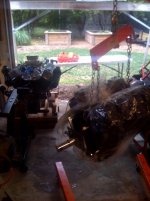....................
Thanks for the detailed response Rick. I appreciate it. I'm actually trying to learn something as I plod along vs. just getting it back together. This information is very helpful.
I'll check,
but I think I have the plain old no frills inductive timing light.
When you say
"Real Degrees and in Real Time" are you referring to looking at the engine vs. a LCD read out or something? I would not know how to use such a tool. I'm still coming to terms with not needing a dwell meter.

While I get some flack from the guys who love to use their Digitally Advancing timing lights, there is part of this that may not be understood.
The D/A timing lights are great...... and when used on a system that incorporates an ECM/ECU that receives engine data input from sensors and then controls spark advance "electronically", the control module can/may accommodate for any small errors.
These systems require a BASE advance only for initial ECU/ECM data.
With a mechanical advancing type ignition, there is little margin for error.
The advancing is done via a mechanical centrifugal system...... No control unit that senses "knock", engine temp, etc.
Once set up, this advance curve will be consistant and progressive per engine RPM!
Only wear and/or rust/corrosion is likely to change this!
When I suggest
Real time/Real degrees, I'm referring to the ole strobe type light being used against a timing tab and real crankshaft degrees that have been marked off onto the Harmonic balancer.
When strobed, these give you real readings.... and do not rely on an electronic algorythm as per the D/A timing lights!
IMO, this equates to less chance of user error, less chance of equipment error and/or undetected equipment failure, etc.
It is not a risk that I am willing to take, sinse total advance in the correct range is so dam important for performance.
However, and IMOO, more importantly is the potential damage that TOO MUCH TA can cause an engine!
Most DA timing lights can be used in strobe mode only, I believe.
All you need is for the tab and balancer to offer you these markings.
It is extremely simple to do!
It's your call..... I'm simply suggesting what/how I would do this myself.
BTW, I learned much of this in the 60's from a man who was then, the oldest drag racer in America (72 years old at the time).... Mr. Vic McCrosky in Gresham, Oregon!
He was nice enough to allow me into his shop while he tinkered with his B gas dragster.
I think that he noticed my interest, since I had already become a SBC enthusiast by that time.
Vic just nudged me some by explaining Ignition, camshaft and crankshaft indexing....... piston combinations, cylinder head charcteristics, etc.
Of course there were no D/A type timing lights back then....... Strobe ONLY!
The hot ignition systems were Magnetos, fuel injection systems were not timed, No ECU's, and so on.
Quite different these days, but many basics are unchanged, and many of these principles can be used today!

Marine specs are certainly different, and I'd never advise anyone to rely on info from automotive "Gear Heads" and/or "Machinists" alone!
Not unless they have hands-on marine cruiser experience including owning their own cruiser type boat.
The basics as for Ignition timing, phasing/indexing components, etc, are very much the same in procedure only.
Specs will always be different!
Point being on that..... is to caution those of us taking advice from primarily automotive enthusiasts!
.


